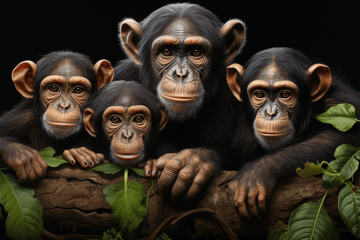Nestled within the lush rainforests of Central and West Africa, chimpanzees, our closest living relatives, captivate our imagination with their remarkable intelligence, complex social structures, and uncanny resemblance to humans. Their fascinating behavior, ranging from sophisticated communication techniques to ingenious tool use, provides a glimpse into the evolutionary history and cognitive prowess of these remarkable primates.

Communication: A Symphony of Vocalizations, Facial Expressions, and Body Language
Chimpanzees possess a rich and diverse repertoire of communication methods, far surpassing anything observed in other animal species. Their vocalizations, ranging from grunts and barks to screams and pant-hoots, convey a wide range of emotions, from fear and aggression to excitement and contentment. These vocalizations are often accompanied by expressive facial displays, such as bared teeth, furrowed brows, and playful grimaces. Chimpanzees also engage in elaborate body language, using gestures such as arm waving, body rocking, and grooming to reinforce their messages.
Tool Use: Masters of Innovation
Chimpanzees are renowned for their remarkable tool-using abilities, demonstrating a level of ingenuity and problem-solving skills that rival that of our own species. They have been observed using sticks to extract termites from their mounds, stones to crack open nuts, and even spears to hunt small mammals. Their tool use is not limited to foraging and hunting; they have also been known to use tools for self-care, such as sticks to remove parasites from their fur.
Social Interactions: A Complex Tapestry of Relationships
Chimpanzees live in complex social communities, ranging from a few dozen individuals to over 150 members. These communities are characterized by a hierarchical structure, with dominant males and females leading the group. Social interactions within chimpanzee communities are intricate and multifaceted, involving cooperation, competition, conflict resolution, and alliances. Chimpanzees form strong bonds with their mothers, siblings, and close companions, exhibiting behaviors such as grooming, food sharing, and consoling.
Intelligence: A Window into Our Evolutionary Past
Chimpanzees possess exceptional cognitive abilities, demonstrating problem-solving skills, self-awareness, and even empathy. They can learn to use symbols to represent objects, understand the concept of deception, and even exhibit mirror self-recognition, a behavior considered a hallmark of human intelligence. Studying chimpanzee intelligence provides valuable insights into the evolutionary origins of human cognition and the shared cognitive traits that unite us with our closest living relatives.
Conservation Challenges: Protecting Our Primate Heritage
Despite their remarkable intelligence and adaptability, chimpanzees face a multitude of conservation challenges. Habitat loss due to deforestation, poaching for the bushmeat trade, and the spread of infectious diseases threaten their survival in the wild. As a result, chimpanzees are classified as Endangered on the IUCN Red List of Threatened Species. Conservation efforts are underway to protect chimpanzee habitats, reduce poaching, and promote community-based conservation initiatives.
Chimpanzees: A Mirror to Ourselves
By studying chimpanzees, we gain a unique perspective on our own evolutionary history, the complexities of animal intelligence, and the profound connection we share with our closest living relatives. Their fascinating behavior, ranging from sophisticated communication to ingenious tool use, reminds us of our shared primate heritage and the importance of preserving the rich biodiversity that sustains our planet. As we continue to unravel the mysteries of chimpanzee behavior, we deepen our understanding of ourselves and the remarkable diversity of life that surrounds us.

